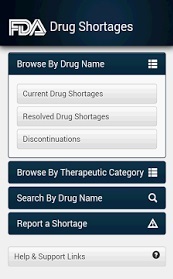 |
| The "Drug Shortages" app--Courtesy FDA |
Several factors in the manufacturing process can lead to a drug shortage. Now, the FDA has launched an effort to combat the effects of such shortages, bringing the battle to your smartphone.
The agency announced its "Drug Shortages" app on Wednesday, aimed at allowing the public quick access to information on current shortages, resolved shortages and discontinuations.
"The FDA understands that health care professionals and pharmacists need real-time information about drug shortages to make treatment decisions," said Valerie Jensen, associate director of the Drug Shortage Staff in the FDA's Center for Drug Evaluation and Research. "The new mobile app is an innovative tool that will offer easier and faster access to important drug shortage information."
In recent years, government agencies have found that though the rate of new shortages decreased, the total number of shortages continued to rise every year since 2007 because many older shortages weren't resolved. For instance, there were 456 active drug shortages in 2012; 195 new ones and 261 that began before 2012 but remained active.
A variety of factors--from recalls to supply chain issues--can contribute to a shortage of a drug. The incidents can delay or deny needed care for patients, the FDA says, and may lead health care professionals to rely on less-effective or higher-risk alternatives.
The new app allows users to find shortages by using a drug's generic name or active ingredient or browsing therapeutic categories. Users can also send a report of a suspected drug shortage to the agency. It is available via a free download on iTunes and the Google Play store and can be found by searching "FDA Drug Shortages."
Last month, a Pew Charitable Trusts report found that tackling the drug shortage problem will take a multi-pronged attack by regulators, payers and industry. One such move by the FDA was to require that drugmakers report potential shortages, allowing the agency to prevent or mitigate some.
Still, shortages persist. An example is saline, which has been in low levels for more than a year. That shortage was caused by big demand which was exacerbated by recalls from Hospira ($HSP), Baxter ($BAX) and B. Braun. The FDA has been working with the three drugmakers to increase production of the essential product and also has temporarily allowed it to be imported from a couple of plants outside of the U.S. that are not approved to sell here.
- here's the FDA release
- and here's Pew's release
- check out the Pew report